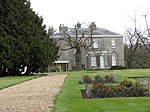Trafford Mausoleum, Wroxham
Anthony Salvin buildingsBuildings and structures in NorfolkGothic Revival architecture in NorfolkGrade II listed buildings in NorfolkGrade II listed monuments and memorials ... and 2 more
Mausoleums in EnglandMonuments and memorials in Norfolk

The Trafford Mausoleum, is a memorial in Wroxham, Norfolk, England. Commissioned after the death of Sigismund Trafford Southwell in 1827, the mausoleum was designed by Anthony Salvin in Gothic Revival style. It is a Grade II listed structure.
Excerpt from the Wikipedia article Trafford Mausoleum, Wroxham (License: CC BY-SA 3.0, Authors, Images).Trafford Mausoleum, Wroxham
Saint Mary's Close, Broadland
Geographical coordinates (GPS) Address Nearby Places Show on map
Geographical coordinates (GPS)
| Latitude | Longitude |
|---|---|
| N 52.7069 ° | E 1.3978 ° |
Address
Saint Mary's Close
NR12 8SG Broadland
England, United Kingdom
Open on Google Maps







